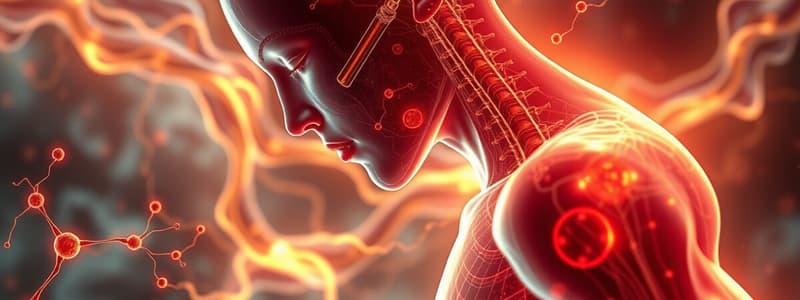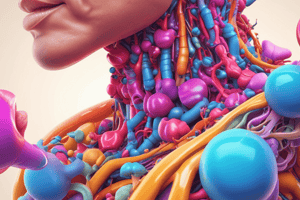Podcast
Questions and Answers
How does thyroid hormone (TH) influence lipolysis and lipogenesis?
How does thyroid hormone (TH) influence lipolysis and lipogenesis?
TH increases lipolysis and decreases lipogenesis in connective tissue cells.
What is the glucose-sparing effect?
What is the glucose-sparing effect?
The glucose-sparing effect refers to the preservation of blood glucose for the brain by utilizing fatty acids for cellular respiration.
How does TH affect respiration rate?
How does TH affect respiration rate?
TH stimulates an increase in respiration rate to meet the higher oxygen demands of the body.
What role do sodium-potassium (Na+/K+) pumps play in the response to TH?
What role do sodium-potassium (Na+/K+) pumps play in the response to TH?
Explain the relationship between the second law of thermodynamics and energy conversion in cells.
Explain the relationship between the second law of thermodynamics and energy conversion in cells.
How does TH affect heart function?
How does TH affect heart function?
Why is increased heat production significant in the context of TH?
Why is increased heat production significant in the context of TH?
What is the impact of TH on cellular receptors for epinephrine and norepinephrine?
What is the impact of TH on cellular receptors for epinephrine and norepinephrine?
What role does glucose play in nervous tissue, and why is it considered vital?
What role does glucose play in nervous tissue, and why is it considered vital?
Describe the initial physiological changes that occur during the alarm reaction.
Describe the initial physiological changes that occur during the alarm reaction.
How does the hypothalamus contribute to the alarm reaction?
How does the hypothalamus contribute to the alarm reaction?
What is gluconeogenesis, and how does it relate to the body's response to stress?
What is gluconeogenesis, and how does it relate to the body's response to stress?
Explain the effects of lipolysis and its components during the alarm reaction.
Explain the effects of lipolysis and its components during the alarm reaction.
What happens to glucose uptake in cells during the stress response, and what is the consequence?
What happens to glucose uptake in cells during the stress response, and what is the consequence?
Identify the hormones released by the adrenal medulla during the alarm reaction and their function.
Identify the hormones released by the adrenal medulla during the alarm reaction and their function.
Discuss how protein metabolism is affected during the alarm reaction.
Discuss how protein metabolism is affected during the alarm reaction.
What are the primary functions of the pancreas in the endocrine system?
What are the primary functions of the pancreas in the endocrine system?
What type of cells in the pancreatic islets are responsible for insulin secretion?
What type of cells in the pancreatic islets are responsible for insulin secretion?
How does insulin affect blood glucose concentration?
How does insulin affect blood glucose concentration?
Describe the role of glucagon in blood glucose regulation.
Describe the role of glucagon in blood glucose regulation.
What is the relationship between the pancreas and the duodenum?
What is the relationship between the pancreas and the duodenum?
What histological features distinguish different types of islet cells in the pancreas?
What histological features distinguish different types of islet cells in the pancreas?
Explain the importance of homeostasis in relation to insulin and glucagon.
Explain the importance of homeostasis in relation to insulin and glucagon.
In what ways might malfunction of the pancreatic islets affect health?
In what ways might malfunction of the pancreatic islets affect health?
What role does CRH play in the regulation of ACTH and cortisol?
What role does CRH play in the regulation of ACTH and cortisol?
Identify the primary target organs of cortisol and describe its effect on each.
Identify the primary target organs of cortisol and describe its effect on each.
Why is the pancreas classified as both an exocrine and an endocrine gland?
Why is the pancreas classified as both an exocrine and an endocrine gland?
Compare the functions of alpha cells and beta cells within the pancreatic islets.
Compare the functions of alpha cells and beta cells within the pancreatic islets.
What is the significance of somatostatin released by delta cells in the pancreas?
What is the significance of somatostatin released by delta cells in the pancreas?
Outline the metabolic effects of glucagon on target tissues.
Outline the metabolic effects of glucagon on target tissues.
Discuss the role of pancreatic polypeptide secreted by F cells and its potential effects.
Discuss the role of pancreatic polypeptide secreted by F cells and its potential effects.
Explain the structural organization of pancreatic islets.
Explain the structural organization of pancreatic islets.
What hormone is released in response to low blood glucose levels?
What hormone is released in response to low blood glucose levels?
How does insulin affect blood glucose levels?
How does insulin affect blood glucose levels?
What controls the release of insulin from the pancreas?
What controls the release of insulin from the pancreas?
Which cells in the body do not require insulin for glucose uptake?
Which cells in the body do not require insulin for glucose uptake?
What is the role of cAMP in glucagon signaling?
What is the role of cAMP in glucagon signaling?
What are the two main metabolic processes activated by glucagon in response to low blood glucose?
What are the two main metabolic processes activated by glucagon in response to low blood glucose?
What effect does decreasing insulin levels have on alternative nutrient usage?
What effect does decreasing insulin levels have on alternative nutrient usage?
How is the release of glucagon initiated?
How is the release of glucagon initiated?
Flashcards are hidden until you start studying
Study Notes
Thyroid Hormone (TH) Effects
Thyroid hormone plays a crucial role in regulating metabolic processes throughout the body.
- Connective tissue cells increase lipolysis and decrease lipogenesis in response to TH.
- Glycerol and fatty acids are released into the blood, serving as alternative nutrient molecules for cellular respiration, which conserves blood glucose for the brain (glucose-sparing effect).
- TH stimulates synthesis of sodium-potassium (Na+/K+) pumps, enhancing movement of these ions across cell membranes.
- Increased Na+/K+ pumps lead to greater ATP conversion into mechanical energy, resulting in higher heat production and body temperature.
Alarm Reaction to Stress
- The alarm reaction is the body's immediate response to stress, regulated by the sympathetic division of the autonomic nervous system.
- The hypothalamus activates this system, leading to adrenal medulla stimulation and release of epinephrine and norepinephrine.
- Physiological changes occur: pupil dilation, bronchiole dilation, and increased respiration rate.
- To meet energy demand, gluconeogenesis increases in the liver, raising blood glucose levels and providing alternative nutrients for energy production from glycerol and amino acids.
Pancreas Anatomy and Function
- The pancreas acts as both an endocrine and an exocrine gland, contributing to digestion and hormone regulation.
- Composed of pancreatic islets, which contain alpha cells (produce glucagon) and beta cells (produce insulin).
- Minor cell types include delta cells (secrete somatostatin) and F cells (secrete pancreatic polypeptide).
Insulin and Glucagon Regulation
- Insulin lowers blood glucose levels by facilitating glucose uptake into cells, especially when glucose levels are high.
- Some cells, such as neurons and kidney cells, do not require insulin for glucose uptake.
- Glucagon is released in response to low blood glucose levels, stimulating glycogenolysis and gluconeogenesis to raise blood glucose concentration.
- Insulin release is regulated by negative feedback; as blood glucose decreases, insulin release diminishes.
Studying That Suits You
Use AI to generate personalized quizzes and flashcards to suit your learning preferences.




